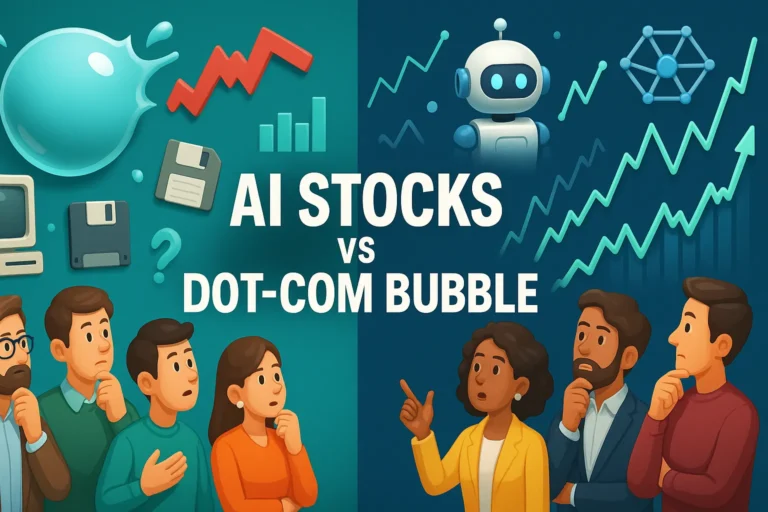
7 Critical Predictions: Is the AI Stock Boom Another Dot-Com Bubble or Not?
7 Critical Predictions: AI stocks vs dot com bubble — Is the Boom Real or 90s Rerun?
Last updated: September 17, 2025 • Target length: ~3,000 words
⚡ Quick Take (open me)
Is the current AI mania another 1999 moment? In this guide we map seven evidence-based predictions comparing AI stocks vs dot com bubble: earnings power vs narratives, capital intensity, platform economics, hardware bottlenecks, regulation, and cycle timing. You’ll see where the parallels are real, where they’re misleading, and how to position with rules that protect you whether or not a bust arrives.
Every generation gets its “this time is different” story. The 1990s had broadband and eyeballs; 2023–2025 has GPUs and tokens. If you’re wondering is AI a bubble, you’re not alone. Some AI leaders post real cash flow; others ride valuation multiples that assume flawless adoption curves. This article doesn’t pick heroes or villains—it lays out AI stock market predictions and risk controls so you can compound through whatever comes next.
- 7 predictions that separate technology bubble vs real value—with simple metrics you can track monthly.
- A side-by-side dot com crash comparison (profit quality, capex, dilution, and rates backdrop).
- Specific AI investment risks (supply bottlenecks, vendor concentration, regulatory shocks) and hedges.
- Portfolio playbook: barbell construction, position sizing, and when to rotate toward value or back to growth.
This is an evergreen education piece—no single quarter will decide the debate. Instead, we’ll anchor on metrics you can track over time: free-cash-flow yield vs revenue growth, capex efficiency, inference costs per user, model differentiation, and policy overhang. By the end, you’ll have a checklist to evaluate whether today’s leaders are building durable value—or replaying 1999 with better branding.
Let’s start with the most important signal the dot-com era ignored: cash flow. In the next section, we’ll quantify why profits—not pageviews—separate sustainable AI winners from speculative copycats.
💡 Prediction #1 – Profits vs Promises: Cash Flow Wins
The number one lesson from the dot com crash comparison is that pageviews and “eyeballs” couldn’t pay bills. Companies with no path to profit collapsed when capital dried up. The same applies to today’s AI stocks vs dot com bubble debate: flashy demos don’t matter if free cash flow is negative and dilution is the only funding source.
What to Watch
- Free Cash Flow Yield: Companies generating 3–5% FCF yield with growth can compound sustainably.
- GAAP vs Adjusted Earnings: Mind the gap—dot coms lived on adjusted metrics until reality hit.
- Dilution Trends: Equity issuance should shrink over time, not expand—otherwise shareholders get bled.
If you’re asking is AI a bubble, look here first. Sustainable cash flow is the dividing line between technology as a durable platform and technology as a passing fad.
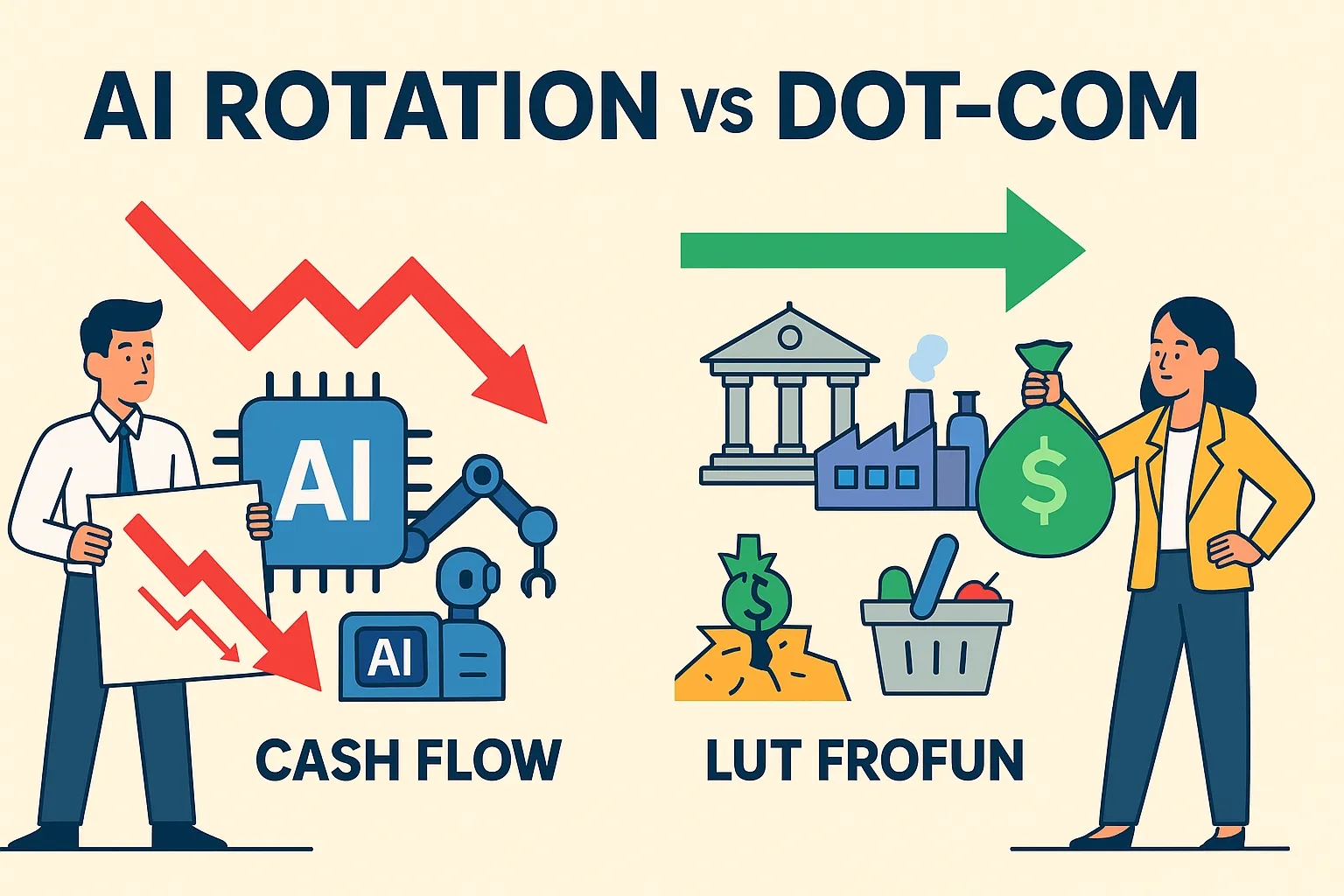
Investors who survived 2000 did so by owning companies with profits. The same principle will protect portfolios in 2025. This is the foundation of smart AI stock market predictions.
⚙️ Prediction #2 – Hardware Bottlenecks & Capital Cycles
The dot com boom was constrained by bandwidth and server costs; scaling eyeballs required expensive infrastructure. Today’s AI revolution faces a similar challenge: GPUs, energy demand, and data center capacity. Capital intensity is the echo that links AI stocks vs dot com bubble.
Why This Matters
- Capex Discipline: Firms with efficient spending on chips and data centers will outlast those burning capital.
- Hardware Scarcity: Limited supply of GPUs creates pricing pressure and uneven adoption curves.
- Energy Costs: Power consumption becomes the silent margin killer if ignored.
This is one of the most overlooked AI investment risks. Just like dot coms underestimated bandwidth costs, AI companies may underestimate compute and energy costs. Investors must model total cost of ownership, not just revenue projections.
For a deeper dive into how hardware cycles shape investing, check out our coverage on Ripple Wave Cash, where infrastructure limitations shape price action.
In short: infrastructure constraints can expose hype. By monitoring capex efficiency and hardware availability, you stay ahead of the curve in separating technology bubble vs real value. Next, we’ll explore platform moats—why some models become utilities, while others get commoditized.
🔒 Prediction #3 – Platform Moats vs Commodity Models
One of the clearest signals separating AI stocks vs dot com bubble is whether companies can build durable moats. In the 1990s, internet service providers became commodities while a handful of platforms (Amazon, eBay) built ecosystems. Today, AI firms that provide infrastructure platforms (chips, APIs, cloud) stand a better chance than those selling one-off tools.
Key Differentiators
- Switching costs: Will customers face friction leaving the platform, or can they swap models overnight?
- Network effects: Do more users make the product stronger, or does scale erode margins?
- Data advantage: Proprietary datasets create long-term defensibility, unlike open commoditized models.
In other words: if your model can be cloned by open-source in six months, you may be on the wrong side of technology bubble vs real value. But if your platform embeds deeply into workflows with sticky revenue, you may endure.
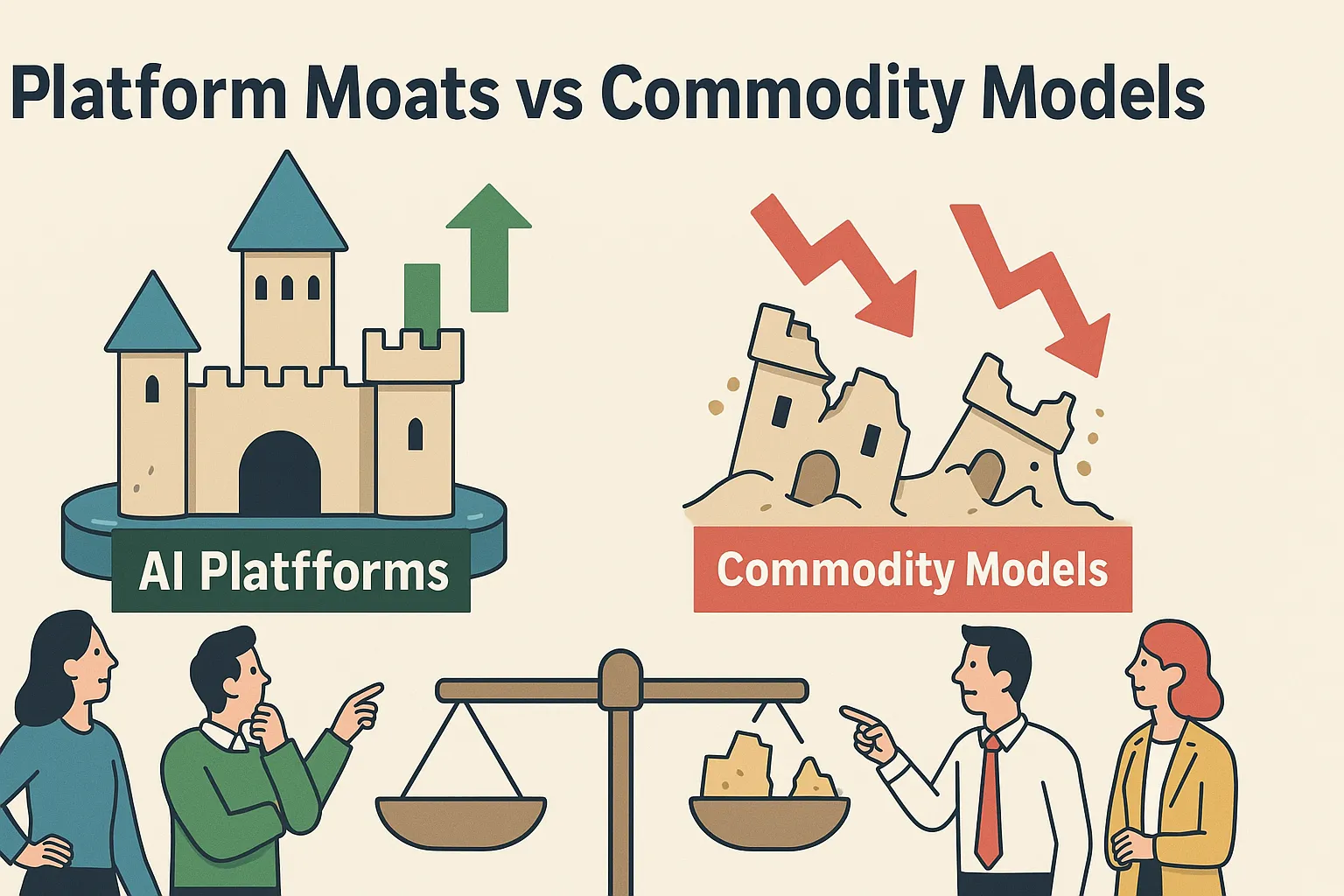
This is where investor perception diverges: AI winners will likely look less like speculative apps and more like infrastructure providers. Owning moats means avoiding the mistakes of the dot com crash comparison.
📉 Prediction #4 – Valuation Gravity: Rates, Margins, Durability
Even the strongest narratives bow to math. During the 2000s, dot coms collapsed because multiples couldn’t stretch forever. Today, many AI stocks trade at 20–30x sales, a level sustainable only if growth lasts a decade. If interest rates stay higher for longer, valuation gravity will pull expectations down.
What to Track
- Price/Sales Ratios: Anything above 15x sales is historically fragile without hypergrowth longevity.
- Gross Margins: Declining margins signal commoditization and weaken durability.
- Discount Rates: The higher the cost of capital, the lower sustainable multiples become.
This is the crux of AI investment risks. Even companies with real revenue face re-rating if the backdrop changes. A true dot com crash comparison lies in valuation discipline: eventually, cash flow must justify multiples.
Want to understand how valuation math impacts portfolio returns? Review our guide on Day Trading Mentor, where we show how multiples compress and expand across cycles.
If you’re questioning is AI a bubble, start by modeling valuations under different rate scenarios. This ensures you avoid confusing narratives with math. Next, we’ll move to regulation—an external force that derailed many internet companies post-2000.
⚖️ Prediction #5 – Regulation & Content Liability Shock
One underappreciated echo in the AI stocks vs dot com bubble debate is regulation. In the early 2000s, internet companies faced a wave of scrutiny around accounting, advertising, and privacy. Today, AI firms may face tighter controls on data use, model transparency, and content liability. The question is AI a bubble isn’t just about multiples—it’s also about policy risk.
Risks to Watch
- Data privacy: Stricter rules could limit training data access, raising costs.
- Copyright claims: Ongoing lawsuits may force companies to license data retroactively.
- AI liability laws: Governments may require firms to bear responsibility for model errors or harmful outputs.
These pressures echo how dot coms underestimated the power of regulators. For investors, regulatory clarity will be as crucial as financial metrics when assessing AI investment risks.
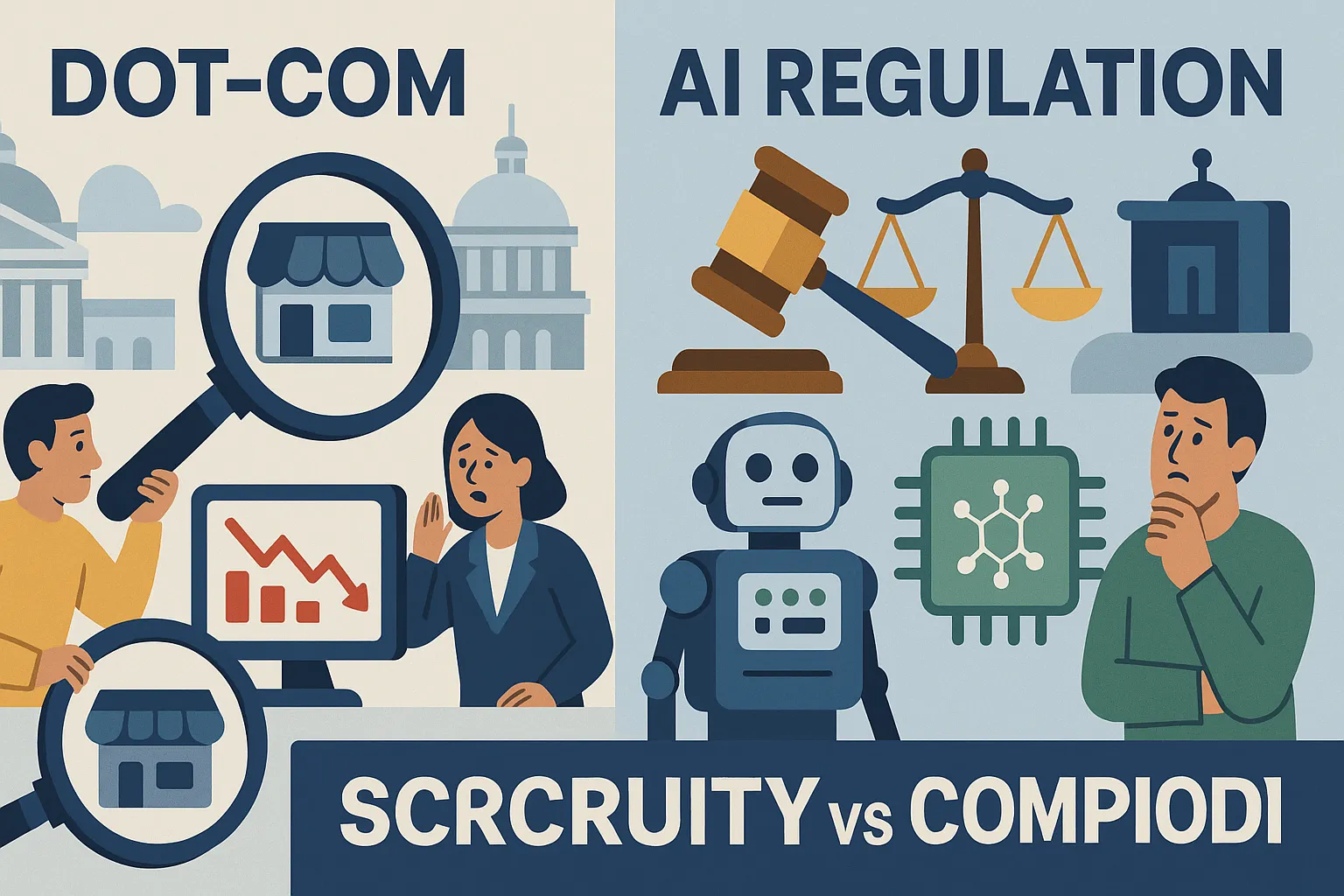
Investors need to factor in headline risks and potential compliance costs. Regulation could decide whether AI firms remain high-margin growth stories or transition into regulated utilities.
📈 Prediction #6 – Adoption S-Curves & Unit Economics
The internet had its S-curve of adoption: slow in the early 90s, rapid by the late 90s, then consolidation after the crash. AI is following a similar trajectory. Adoption is accelerating, but whether revenue and margins scale efficiently will determine if this is a technology bubble vs real value moment.
Signals of Real Value
- Unit economics: Are incremental users profitable, or is each new customer acquired at a loss?
- Retention: Do customers stick around, or churn once hype fades?
- Platform stickiness: Do enterprise clients integrate deeply, or test and move on?
This is one of the most important AI stock market predictions. True adoption curves eventually reveal whether AI is infrastructure like cloud—or a fad like many dot coms that vanished. Watching unit economics keeps you grounded in data, not hype.
For more on adoption curves and timing, review our article on Swing Trading Books, where we break down how cycles unfold in stages and how to align entries with adoption momentum.
With regulation and adoption curves in focus, the final prediction tackles rotation math—how capital shifts from hype to value and what it signals for long-term positioning. That’s where Prediction #7 takes us next.
🔄 Prediction #7 – Rotation Math: When Value Outruns Hype
The final piece of the AI stocks vs dot com bubble debate is capital rotation. In 2000–2002, money didn’t leave markets; it rotated. Value sectors like energy, staples, and financials outperformed as tech multiples collapsed. If AI investment risks play out, expect a similar handoff. Growth may reset, but disciplined capital will chase free cash flow and dividends.
Rotation Signals
- Sector breadth: Watch if gains spread beyond top AI leaders into undervalued groups.
- Factor performance: When value factors outperform growth, rotation is underway.
- ETF flows: Rising flows into dividend/value ETFs signal defensive positioning.
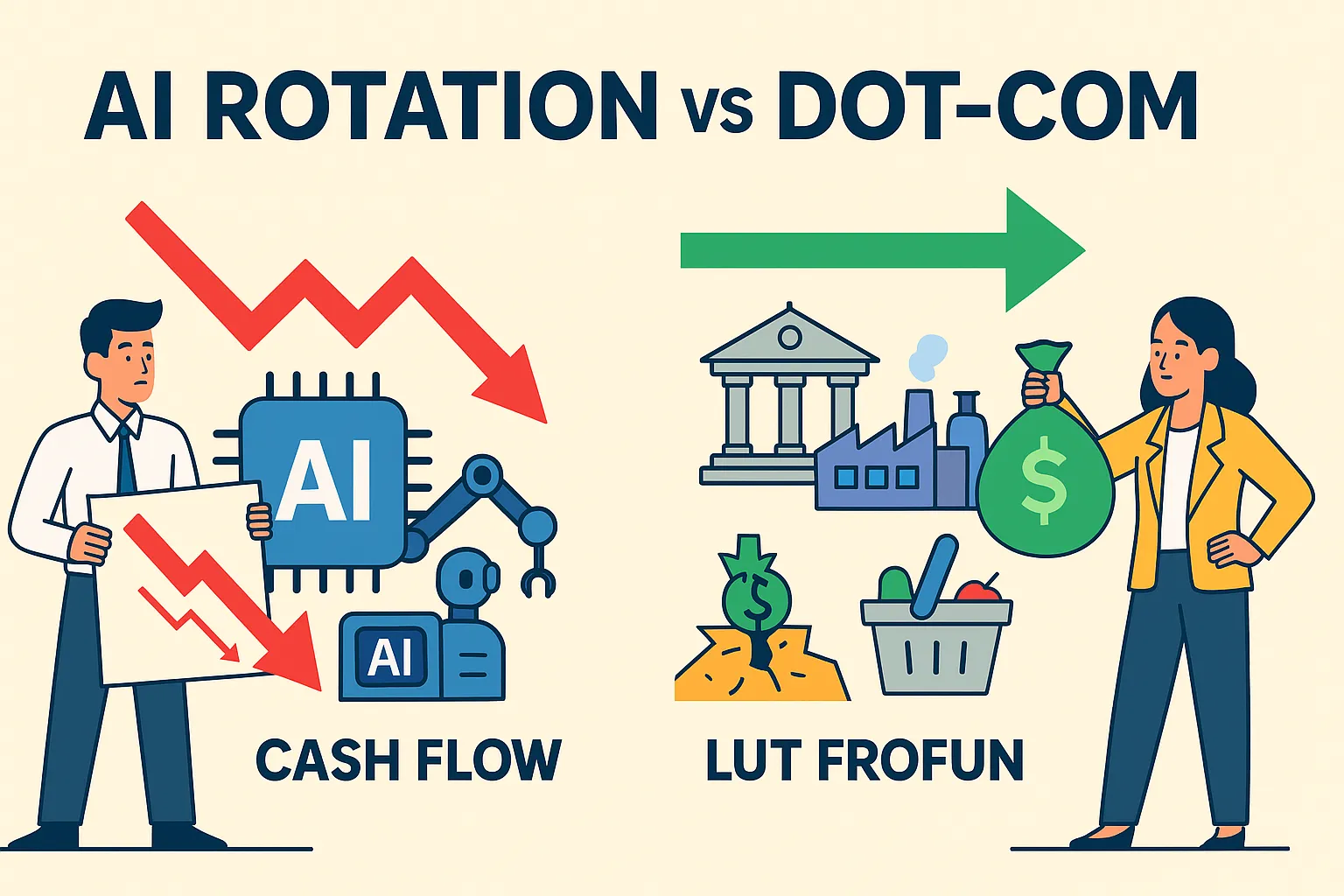
This is why barbell portfolios—mixing durable value with selective growth—tend to outperform in uncertain cycles. Rotation math ensures you benefit no matter which narrative wins.
📘 Portfolio Playbook: Hedging AI Booms & Busts
Instead of predicting a crash or doubling down on hype, smart investors use a framework. The dot com era taught us that portfolio construction—not market timing—decides survival. Apply these rules when navigating AI stock market predictions:
- Barbell approach: Anchor in value (pharma, financials, staples) while maintaining small growth exposure.
- Position sizing: No single AI name should exceed 5% of portfolio; spread bets across themes.
- Liquidity awareness: Avoid thinly traded speculative AI names—dot com penny stocks wiped out portfolios.
- Cash buffer: Holding dry powder lets you add during pullbacks, not panic sell.
- Regular reviews: Track free cash flow, margins, and adoption rates quarterly.
For additional strategies on timing entries and exits, read our Penny Stocks Watch List, where we explain how disciplined setups outperform emotional trades.
❓ FAQs on AI Stocks vs Dot Com Bubble
1. Are AI stocks in a bubble?
Some are. Companies with profits and durable moats may endure, but speculative names without cash flow resemble dot com excess.
2. How is this different from the dot com crash comparison?
AI leaders often generate real revenue, unlike many dot coms. However, valuation extremes mirror the 1999 environment.
3. What are the top AI investment risks?
Hardware costs, regulation, dilution, and adoption uncertainty are key risks that investors must model.
4. How should I position my portfolio?
Use a barbell strategy: combine value with select growth, manage position sizing, and review fundamentals quarterly.
5. What’s the long-term outlook?
AI may reshape industries, but cycles of hype and rotation are inevitable. Discipline ensures survival through both.
✅ Conclusion & Next Steps
The debate over AI stocks vs dot com bubble won’t end in one quarter. The truth lies in the data: free cash flow, adoption curves, capital discipline, and rotation signals. Whether AI becomes the backbone of productivity or suffers a speculative reset, disciplined investors can win by focusing on technology bubble vs real value.
By following these 7 predictions and applying a portfolio playbook, you insulate yourself against hype while positioning for upside. History doesn’t repeat exactly, but it rhymes—and investors prepared for echoes of 2000 will thrive in 2025 and beyond.
🚀 Next Step: Protect Your Portfolio
Start with our resources: Stock Market for Dummies PDF and Day Trading Mentor. Build resilience before the next rotation decides winners and losers.